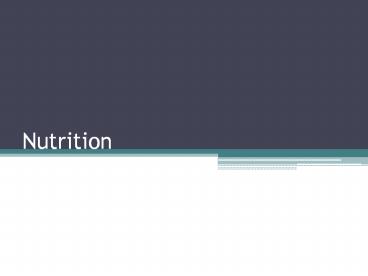Nutrition - PowerPoint PPT Presentation
Title:
Nutrition
Description:
Nutrition Child & Adolescent Nutrition Differs from adult nutrition. Infancy needs Toddlers Adolescents Nutritional Needs Iron is important From toddlers to ... – PowerPoint PPT presentation
Number of Views:187
Avg rating:3.0/5.0
Title: Nutrition
1
Nutrition
2
Child Adolescent Nutrition
- Differs from adult nutrition.
- Infancy needs
- Toddlers
- Adolescents
3
Nutritional Needs
- Iron is important
- From toddlers to teenagers
- Special dietary needs for teenagers
- This is a time of growth spurts
- 20 of adult height
- 50 of adult weight
4
Iron Deficiency Anemia
- What is anemia?
- Symptoms
- Fatigue / weakness
- Pale skin
- Rapid heartbeat
- Irritability
- Decreased appetite
- Dizziness / Lightheadedness
5
Preventing Anemia
- Foods rich in iron
- Red meat, tuna, salmon, eggs, enriched grains,
leafy green vegetables, fortified foods - May need a supplement
- Recommended amounts
- 7-10 mg/day for children 1-12 years old
- 11 mg/day for adolescent boys 15 mg/day for girls
6
Teenagers and Calcium
- Teenagers need calcium to build strong bones
- Calcium is also important for muscle contractions
- The osteoporosis connection
- Why talk about this in a child adolescent
health class??
7
Osteoporosis
- 1 of every 2 American women will get osteoporosis
after the age of 65. - Why worry about teenagers?
- Less than half of teenagers get enough calcium in
their diet. - For girls about 15 get enough calcium.
- The teenage years are the time to build strong
bones
8
(No Transcript)
9
Soda consumption Osteoporosis
- Girls who drank soft drinks 3x more likely to
have a bone fracture - Physically active girls 5x more likely to have a
bone fracture - Why?
- Phosphoric acid
- Less calcium consumption
- Source Harvard School of Public Health
10
Who is at risk?
- Those who do not get enough calcium
- Females
- Those with high soft drink consumption
- Those who do not exercise
- Caucasians and Asians
- Family history
- Smoking
- Alcohol
11
Prevention
- Eating calcium-rich foods
- Dairy products, calcium-fortified orange juice,
leafy green vegetables, canned salmon or tuna - May need a calcium supplement
- Weight-bearing exercises
- Limit soft drink consumption
- Dont smoke
- Notice anything about this list?
12
Selling it to teenagers
- Make it beneficial in the short term
- May need to relate it to body image
- Calcium will help you grow taller
- Do you know those older people that are stooped
over? - Low-fat, non-fat alternatives for those worried
about gaining weight.
13
Eating Disorders
14
Teenagers Eating Disorders
- Girls 15 19 years old
- Account for 40 of new anorexia cases every year.
- There has been a rise in anorexia among this age
group every decade since 1930! - Bulimia
- The incidences of bulimia have tripled among
10-39 year-olds from 1988 to 1993 - Most of those with anorexia or bulimia do NOT
receive adequate care.
15
Teenagers Dieting
- Over ½ half of teenage girls and 1/3 of teen boys
use unhealthy weight control behaviors. - (Neumark-Sztainer, 2005)
- These behaviors include
- Skipping meals
- Fasting
- Smoking cigarettes to control weight
- Vomiting
- Taking laxatives
16
The Female Athlete Triad
- What is it?
- Disordered eating
- Bone loss
- Amenorrhea
- Who is at risk?
- Consequences?
17
Eating Disorders Media
- Tweens Teens are more likely to be dissatisfied
with their bodies after watching media. - Movies Television shows often have characters
comment on appearance/weight. - Advertisements often use an appeal to beauty to
sell the product. - National Institute on Media and the Family
18
Anorexia Nervosa
- Self-starvation
- Essential nutrients are denied (no or little
food) so the body slows down all normal processes
to conserve energy. - Health consequences
- Low blood pressure / heart rate
- Muscle loss / weakness
- Dehydration
- Fainting / fatigue
- Dry hair and skin
19
- 90-95 are female so, 5-10 are male.
- Similar characteristics
- Preoccupied with weight
- Males may have preoccupation with body building,
weight lifting or toning. - Compulsive exercise
- Frequently weighing oneself
- Distorted body image
20
(No Transcript)
21
Bulimia Nervosa
- Typically a binge purge method
- Binge secret periods of quickly eating
high-calorie dense foods. - Purge more than the typical vomiting.
- 80 are female
- Health consequences
- Irregular heartbeat heart failure death.
- Tooth decay
- Ulcers
22
Warning Signs
- Anorexia
- Becomes very thin
- Obsesses over eating, food, weight
- Counts portions, calories carefully
- Only eats certain foods
- Feels fat
- Withdraws from social activities
- May be depressed, fatigued or cold all the time
- Bulimia
- Fears weight gain
- Intensely unhappy with body size, shape or weight
- Goes to the bathroom frequently or immediately
after meals - Regularly buys laxatives
- Spends most of free time working out
- Withdraws from social activities
23
Prevention
- Examine your own body image
- Avoid power struggles over food
- Create a healthy lifestyle for the family
24
More information
- Dying to be thin www.pbs.org
- Nova program































